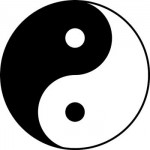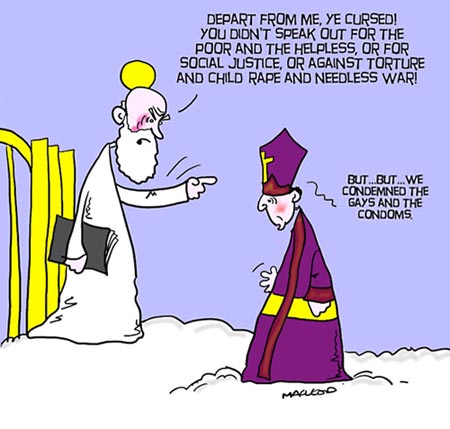 The yin-yang symbol intrigues me. It attracts a part of me beyond reason, similar to an attractive painting in the art gallery. It reminds me of my own light and dark sides as a person. I suspect it applies to the Lasallian family as an organization.
The yin-yang symbol intrigues me. It attracts a part of me beyond reason, similar to an attractive painting in the art gallery. It reminds me of my own light and dark sides as a person. I suspect it applies to the Lasallian family as an organization.
Personal Shadow
Carl Jung might say my ego (what I know about myself) and my persona (the way I want to appear to the world) make up my light side. The dark side for Jung is my unconscious side where I hide unwanted qualities — the characteristics of my personality that I disown. These are ways of behaving that culture and family and experience have taught me warrant a “bad Edward” assessment. If ignored or denied, these characteristics become repressed. The repressed parts of ourselves become unconscious and form the shadow — the other side of my persona and ego.
Since it resides in my unconscious, I become aware of my shadow content only in dreams or when I get particularly upset at behavior I see in others. The heat and energy that emerges from deep within me is a sure sign that what I see in others is mostly my own dark side projected on them. If I get upset at the waitress that fails to bring me mayonnaise for my BLT, it is the energy of the upset that tells me it is more about my shadow than about the lack of mayonnaise.
The shadow is real and in itself a source of considerable energy and power. The most dangerous thing human beings do is deny that shadow exists; denial only strengthens its power and increases the chance of it erupting in a destructive manner. It’s like the road rage over a parking space.
And there is more to shadow. I have an ideal shadow even more intractable than the dark one — and harder to grasp. I perceive these ideal behaviors as beyond my ability or the occasion for certain failure. I refuse to consider them, relegate them to my shadow and then project them on others.
Is this not the case when the young man falls in love with the person he decides is the ideal woman? The extraordinary qualities he sees in her is often his ideal shadow rather than her real personality. With time he will adjust his assessment in light of the real woman he is just beginning to know. The perfect qualities came out of his ideal shadow and were projected on to her. It is often hard for the lover to understand this and even harder for the rest of us to comprehend our refusal or hesitancy to reappropriate the “gold” of this ideal shadow to ourselves.
The goal of my life is to recognize and accept my light and dark sides and realize how I deal with them when they go unreflected. It’s about balance. Much of life’s journey of becoming a whole person is the work of learning how to reintegrate those aspects of ourselves that have been stored or stuffed in the recesses of our psyche. The dark (yin) and the light (yang) are not opposing forces within me, but rather complementary to each other.
Organizational Shadow
Similar to each of us as individuals, organizations and groups have a group ego and persona that shines bright on websites, newsletters, strategic plans, and PowerPoint presentations. It’s the organizational culture. Rarely talked about and often missing from the website is the darker side of the organization — its shadow.
For example, in organizations in which conflict is not acceptable, denial and repression of differences becomes the norm and lead to avoidance of conflict. The causes of conflict remain and those within the organization can’t learn the adaptive skills needed to resolve conflict because it can’t be acknowledged. Considerable effort and energy may be expended and wasted to keep any differences from occurring or to avoid issues that might lead to conflict.
Other examples of shadow include overly polite behavior in meetings in which nothing of substance gets discussed; an emotional overreaction to an issue, or extreme defensiveness; a pattern of dull and predictable meetings, during which the designated leader drones through an agenda with information overload; meetings in which no one in the group speaks or shares an opinion that differs from that of the leader.
The ideal shadow of an organization is purely and simply the good work it was founded to accomplish which current leaders determine is not attainable today.

Cartoon courtesy Hugh MacLeod http://macleodcartoons.blogspot.com/
Both ideal and dark shadow can be denied or projected on other organizations with or without the members ever realizing what they are doing. The hierarchy of the Catholic Church in recent years has all but denied its darkest shadow and projected its ideal shadow on other groups such as it did with the American nuns. And of course, their organizational effectiveness is compromised by the lack of balance and the needless projections they go through. Repression and suppression of shadow is energy consuming, and reduces creativity and productivity in the organization.
Lasallian Family
Lasallian core principles are usually stated as: respect for all persons, inclusive community, faith in the presence of God, quality education and concern for the poor and social justice. Association is the word used to capture the close working relationship of all Lasallians to achieve these core principles. We give the impression that Lasallians are equal; that we are all part of one enormous circle; that differences in age, education, vocation in life enhance the relationship, and that diversity in religion and culture complement the association to deliver the best care to students and their families. It’s the main thesis of Superior General Brother Álvaro’s Circular 461, Associated for the Lasallian Mission…an Act of Hope. It is the light side of our
Lasallian family.
Regarding the equality issue, what is seldom stated on websites and in literature is the values that lurk in the shadow of this organization worldwide and in individual local entities. Hierarchy, chain of command, old boy networks, “Brothers know better,” uniformity of committee membership are shadow values that continue to be held because they are still rooted in many members psyche. How long will it be before we live more by our creed?
Brother Álvaro in Circular 461 spoke about Lasallian Association in terms of: a disposition of solidarity with other Lasallians; a seeking to be sustained by Lasallian spirituality; a clear sense of belonging to this story; a participation in some community experience; and an interest in and openness toward the universality of the Lasallian mission. He was exceptionally candid in naming the Lasallian shadow when he mentioned some sectors of the family lagging behind in embracing the contribution of women Lasallians and on implementing accepted practices of Association. And, of course, he really spoke on inequality when stating there were no second class citizens in the family.
Lasallians who strongly identify with the core principles, and have little patience engaging the dark side are contributing to a lack of dialogue, discussion and debate so much needed in any organization to achieve and maintain balance and credibility for their mission. This classic intolerance proves the organization cannot live totally on one side. To express light so vehemently is to create more shadow. The organization does not move toward wholeness but rather toward dysfunction.
Brother Álvaro quotes one of the General Chapters on the importance of balance:
“It is essential to maintain a dynamic balance between unity and diversity in the Institute… This appears to be indispensable in a rapidly changing world that requires response and flexibility.”
As I grow in awareness of my shadow or wounded side, I realize there is an unexpected gift there. “Gold” is the word used by Robert Johnson, a noted Jungian therapist. I become both sons in the Prodigal Son tale and a balanced human who can then do some good as a wounded healer.
It’s a paradox we carry together also as a Lasallian family. It’s messy, time consuming and humbling — but unifying. Discussion, disagreements, dialogue, and debate will be everywhere and open; but the family will be engaged and effective beyond belief.
Brother Ed Phelan, FSC, believes that all the needs we as individuals have to be our best are true of organizations like the Lasallian family. He loves to help the Lasallian Volunteers to delve into this understanding.


Leave A Comment